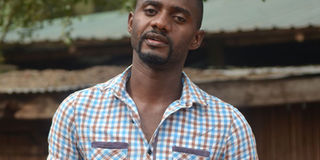The dark side of growing up in a childcare facility

Joel Sserwadda makes a point during the interview recently. PHOTO BY ESTHER OLUKA
What you need to know:
- INSIDEOUT. Joel Sserwadda, 26, spent a bigger part of his childhood at a childcare facility in Masaka District. He shares his experience, both good and bad, of life at the institution with Esther Oluka.
Joel Sserwadda had a tough childhood. When he was born 26 years ago, his family went into chaos after finding out that the toddler had HIV/Aids. It was later found out that his father also suffered from the same disease. Shortly after, Sserwadda’s mother left the home with her older daughters, leaving behind Sserwadda and his father.
A few months later, Sserwadda’s father succumbed to the disease. The toddler, who was barely a year old, was then taken into the care of a foster mother, a woman with strong Christian values.
During his early childhood, Sserwadda grew up at the woman’s residence in Masaka with her children and husband.
“Everyone at the home was very good to me. They loved and cared for me,” he says.
However, after Sserwadda turned four, the situation at the home started to change.
“The family began to struggle financially and could barely keep up with looking after me. I was young and in a fragile state because of my HIV status. They could no longer afford my medication,” he explains.
For this reason, the family was left with no choice but to take Sserwadda to a child care institution , which was also in Masaka District. The facility took care of children born and living with HIV/ Aids, as well as orphans. They were children of different age groups, including teenagers and those in their 20s.
Life and routine at the institution
At the age of four, Sserwadda started a new life at the facility, which he prefers not to name. In the beginning, his foster mother went to check on him from time to time. These visits were, however, stopped by the administration.
“They did not like the idea of us communicating with the outside world and that’s why my foster mother stopped visiting me,” he recalls.
Slowly, he began adapting to his new life. It felt like a boarding school. There were separate dormitories for boys and girls, a kitchen where meals were prepared, classrooms for lessons, a clinic, playground, prayer place and an entertainment room where they watched TV.
During weekdays, the programme often rotated around waking up, showering, dressing up, taking breakfast and going for lessons, which were conducted within the facility. Then, there was break tea, lunch, and, the afternoon classes. In the evening, they showered, had dinner and on some days, were allowed to watch a bit of television before retiring to their beds.
Although the weekends were a little relaxed, the morning hours were mostly about housework. Despite everything that was going on, Sserwadda always ensured to visit the clinic to receive his medication.
“I was made aware of my health status right from a tender age and I was continuously encouraged to adhere to medication, which advice I always followed,” he says.
During Sserwadda’s earlier years at the facility, most of the things were provided for, including clothing, bedding, shoes, and other essentials such as bathing and washing soap. Things began to change as he grew older.
The dark side of living at the facility
Sserwadda says the older he grew, the tougher things became at the institution.
“They started denying us some basic essentials such as food as well as water and whenever we insisted on receiving them, they would tell us, ‘the older boy and girls’ to pay for them, yet we were not working,” he recalls.
“I don’t know why things started to change but I suspect that funders were starting to pullout from the institution,” he says.
Like any other institution, there were rules and regulations. For instance, the teenagers were not allowed to leave the premises. If anyone dared escape and got caught, they were either punished or advised to leave the institution.
Such confinement would sometimes force children to have sexual relations with one another.
“There were cases where young girls would conceive. They would later have a baby and all stay at the facility. Some girls were unlucky as they died while giving birth,” Sserwadda relates.
Then, there were always allegations of caretakers, both female and male, sexually abusing children. These caretakers included staff members such as doctors, nurses, and guards.
“These were always stories of sexual abuse about staff members taking advantage of children,” he says.
On whether he encountered sexual abuse at the institution, Sserwadda responds, “no, I was probably lucky.”
There was also a tendency of some children secretly borrowing phones from staff members, which they would use for watching pornography.
“The ugly bit is that they would want to practice what they watched with their peers,” he says.
And the routine of often changing caretakers did not allow the youngsters to bond with the children.
Leaving the institution
In 2015, Sserwadda chose to leave the institution.
“I got fed up and walked out,” he says.
He was able to find his foster mother, who once again, welcomed him with open arms.
“She took me under her wings again by allowing me to stay with her family,” he says.
At the time Sserwadda had left the facility, he had dropped out of school in Senior Two, third term.
The school was within the facility. But after moving in with his foster mother, he was able to go back to another school with financial support from The Aids Support Organisation (Taso), Uganda. He completed Senior Four at Nelson Mandela Secondary School in Masaka. Afterwards, he undertook a vocational training course in hairdressing. Today, he is as a hairdresser at one of the salons in Masaka.
Life today
After leaving the institution, Sserwadda says he had to learn how things in the world work.
“The world seemed strange to me because of the confinement at the facility. I had to familiarise myself with how people do things, as well as how the system works,” he says.
But all is well now, especially because of the strong support system from his foster mother. Currently, Sserwadda is trying to find his other surviving family members with the help of a social worker. Regarding what his future dreams and goals are, Sserwadda, who is in a relationship, says for now, he cannot wait to be a father.
For now, the hairdresser says he is happy to be out of the facility.
“These places are not as pleasant as people think,” he concludes.
Experience of baby’s home caretaker
“I took care of children at a baby’s home from the years 2011 to 2014. I saw many things at the home, both good and bad. The positive bit was that at least these children had a roof over their head, clothing was provided to them, as well as accorded medical treatment whenever they feel sick. One of the disturbing things I realised while taking care of these children included them not hitting their milestones.
You would find that some of these children were not growing up as their agemates due to various reasons, including poor health. Then, as caretakers, we depended on a schedule where almost everything had to be done at a particular time. I noticed that some particular caretakers would not feed the children during evening hours because they were hurrying to leave and get back to their respective homes. Some of them would deliberately not even feed the child out of fear that the toddler would soil their bedding and in the end, would be forced to clean up their mess.
Then, during potty time, there were caretakers who would either pinch or slap these children as a tactic for forcing them to either urinate or defecate before going to bed. Although this kind of treatment against children was prohibited, some of the caretakers administered these punishments secretly.”
After leaving the babies’ home in 2014, Nakawuki focused on running her other businesses. including rearing chicken and catering. Currently, she is raising four biological children and is a foster carer to other children who stay at her home.
Harriet Nakawuki, 44, FORMER BABY’S HOME CARETAKER




